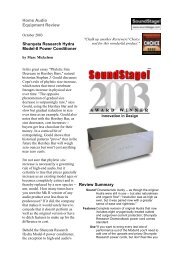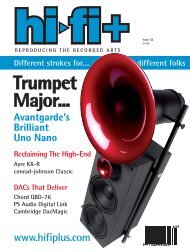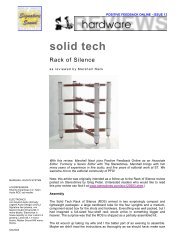Download Model 5 brochure
Download Model 5 brochure
Download Model 5 brochure
Create successful ePaper yourself
Turn your PDF publications into a flip-book with our unique Google optimized e-Paper software.
MODEL5 VOLLVERSTÄRKER
MODEL5 INTEGRATED AMPLIFIER<br />
MAXIMUM PERFORMANCE FOR THE<br />
MONEY<br />
Avantgarde Acoustic, the highly respected manufacturer<br />
of exclusive spherical horn systems have<br />
ventured into the lion’s den and now offers for the<br />
first time a high end integrated amplifier within<br />
their product portfolio. A speaker specialist designing<br />
and manufacturing their own electronics? A<br />
closer look this new project shows a well thoughtout,<br />
coherent and most of all customer friendly<br />
concept.<br />
Horn loudspeakers are not only characterised by<br />
their extreme sensitivity and dynamics, but sometimes<br />
behave with all the agility of a flowering<br />
mimosa. It is true that due to their high impedance,<br />
the horn systems from Lautertal in Germany are<br />
very simple to drive. They simply represent an easy<br />
load for any amplifier, but their incredible resolution<br />
of fine detail quickly reveals the limits of many<br />
highly praised amplification. It is like in real life: for<br />
a good sound you have to combine what is a good<br />
match. An amplifier, which sounds great on a power<br />
demanding speaker system, will not necessarily be<br />
a good match with a horn. Like a big Diesel truck<br />
engine might be ideal to pull a 30-ton load, but in<br />
a racing car, it would certainly be the wrong choice.<br />
The classical virtues of any amplifier “all things to<br />
all men” attach great importance to – output power,<br />
Based on these considerations Avantgarde Acoustic<br />
has invested in a significant research and development<br />
program to realise a unique amplifier concept.<br />
The MODEL5 is a special integrated amplifier,<br />
which ideally matches their ultra dynamic speaker<br />
systems. With surprisingly simple means, the wellknown<br />
virtues of their horns – dynamics, resolution<br />
of fine detail and coherency are emphasized and<br />
brought to life. In this respect the horn specialist<br />
from Lautertal have made a courageous and most<br />
of all consequential step towards further perfecting<br />
their sound systems. Courageous because no other<br />
electronic manufacturer wanted to think about<br />
what’s really needed with the sensitive and revealing<br />
Avantgarde Hornspeakers. Consequential<br />
because a new benchmark in performance – and<br />
in affordability – is now available. Now the music<br />
lover can buy a perfectly balanced amplifier for<br />
their horn system – no “TRIAL & ERROR” when<br />
searching for the perfect sound combination, but<br />
simply “PLUG & PLAY”. “I admit it. We have purposely<br />
played the trump card of our high impedance<br />
and high sensitivity horns, because in combination<br />
with the MODEL5 we managed to achieve a<br />
sound quality at a price which is simply unbeatable<br />
when compared to normal speakers and amplifiers”<br />
states a very pleased Holger Fromme.<br />
In the following pages the special technical features<br />
of the Avantgarde Acoustic MODEL5 amplifier are<br />
explained.<br />
load stability, damping factor etc are of no circumstantial<br />
significance for a horn speaker system. With<br />
a horn, quality is simply more important than<br />
quantity. “I have never excepted that horn customers<br />
have to spend a lot of money for features, they<br />
actually do not need. It was our clear goal to concentrate<br />
on the essentials and design a simple but<br />
perfect amplifier for high sensitivity speakers. No<br />
unnecessary ballast like a big power supply or<br />
oversized transformers and numerous transistors.<br />
Maximum performance for the money!“ explains<br />
Holger Fromme, managing director of Avantgarde<br />
Acoustic.<br />
CLASS A MODE<br />
The MODEL5 is an integrated transistor push pull<br />
amplifier with a power output of 2 x 0.4 watts at<br />
8 ohm in pure CLASS A mode. At 20 ohms 1.1 watts<br />
is available in CLASS A before the amplifier converts<br />
to CLASS AB mode. Thus Avantgarde Acoustic<br />
consequently continiuous its high impedance technology<br />
with all its advantages first introduced in the<br />
TRIO OMEGA model.<br />
By increasing the bias current the CLASS A mode<br />
eliminates distortions when the signal passes the<br />
null point of the signal curve in push-pull ampli-
fiers. The high sensitivity of the Avantgarde Acoustic<br />
horn systems ensure even at this low power output,<br />
that up to 103 dB with the DUO and up to<br />
110 dB with the TRIO the amp works in this optimal<br />
CLASS A mode. Above this power the MODEL5<br />
amplifier operates in CLASS AB mode. The output<br />
power now increases to 2 x 27 watts at 8 ohms,<br />
and in combination with the UNO, DUO and TRIO<br />
this is enough power to really get “rolling”. If the<br />
DUO is connected to the MODEL5 this will translate<br />
into an incredible 118 dB sound pressure level.<br />
This clearly shows that the combination, even when<br />
connected to a small power amplifier is playing in<br />
another league.<br />
Small power and CLASS A mode spontaneously<br />
gives you the subjective impression that this small<br />
amplifier should be a perfectly match with dynamic<br />
horn speakers. Matthias Ruff, the spiritual father of<br />
the MODEL5 amplifier quickly concludes: “Small<br />
power output and a high bias voltage are on their<br />
own no guaranty for a good sound. These are just<br />
simple engineering tools to further optimise the<br />
sound”. The resultant sound is the combination of<br />
all components, and this always includes the speakers.<br />
“How many amplifiers exist, which measure<br />
perfectly when connected to a dummy loudspeaker<br />
load in the laboratory, but when hooked to a real<br />
speaker they simply sound bad.” According to the<br />
chief designer of Avantgarde Acoustic, the reason<br />
can be found in the forces which flow back from<br />
the speakers voice coil into the amplifier. With every<br />
movement of the voice coil, magnetic field currents<br />
are induced which are fed back to the amplifier.<br />
These are called “Electro-Magnetic-Forces” (EMF).<br />
Ideally the amplifier should “suppress” these forces<br />
and control the speaker in every situation. In common<br />
amplifier designs one tries to control these<br />
forces with a high damping factor. With high feedback<br />
the output impedance is reduced and the<br />
damping factor is maximized.<br />
TYPICAL PUSH-PULL TRANSISTOR<br />
AMPLIFIER<br />
The control of these Electro-Magnetic-Forces is difficult<br />
to achieve. To better comprehend the problems,<br />
one needs to understand the operation of a typical<br />
transistor PUSH-PULL amplifier. To achieve outstanding<br />
technical specifications, the vast majority of all<br />
PUSH-PULL amplifiers are usually designed according<br />
to the “High Open Loop Gain” concept. In this<br />
concept the open loop gain of the amplifier is set<br />
very high and the overall signal gain is later reduced<br />
to the desired level by applying very high levels of<br />
feedback. The intention of this circuit design is to<br />
sub sequentially reduce distortions and increase the<br />
damping factor of the amplifier. This “HIGH GAIN<br />
High Feedback” concept (HGHF) in principle is<br />
very easy to implement and at first sight, very logical.<br />
By using several amplification stages the input<br />
signal is first amplified to a level higher than in<br />
actual fact needed. This excessive signal level is<br />
then sub sequentially reduced to the required value<br />
by a high feedback loop. Feedback continuously<br />
compares the amplified output signal of the amplifier<br />
with the input signal, if it detects deviations, the<br />
feedback corrects accordingly. Distortions are effectively<br />
eliminated and at the same time a high<br />
damping factor is achieved. Simply spoken HGHFamplifiers<br />
use the headroom generated by the<br />
excessive high open loop gain to later correct the<br />
“errors” at the output (i.e. distortions etc.) with the<br />
feedback. HGHF-amplifiers thus in general have<br />
very good technical specifications. “Superb technical<br />
measurements in the laboratory are no indication<br />
for good sound,” responds Matthias Ruff angrily.<br />
“Static dummy loads are not speaker systems and<br />
fixed frequencies of an oscillator are not music!<br />
People naively believe in the specs of the data<br />
sheets and are totally surprised when at home it<br />
does not work”. The HGHF-principle is plausible in<br />
theory, but in practical operation generates new<br />
distortions. To better understand one has to take a<br />
closer look at the circuit design of an amplifier. An<br />
amplifier in general has the function to amplify the<br />
input signal (for example: from a CD-player)<br />
through several stages successively up to a level,<br />
which is sufficient to drive a speaker system. To<br />
achieve a high signal gain in HFHF-amps several
sequential amplifier stages are used. Most modern<br />
high performance amplifiers use as many as seven<br />
cascaded stages. In addition the input signal does<br />
not only have to pass through several serial amplifier<br />
stages but most of the amplifiers use several<br />
power transistors in parallel to achieve a higher<br />
power output. In some “monster” amplifier designs<br />
up to 20 power transistors are switched in parallel.<br />
Serial and parallel signal processing have two<br />
major disadvantages. First of all any transistor –<br />
even highest-grade versions produce distortions.<br />
The more stages are used, the higher the distortions<br />
of the circuitry become. And theses “distortions”<br />
do not only add to each other, but multiply together<br />
as well. This is because every stage amplifies the<br />
distortions of the previous stage and modulates its<br />
own distortions on top of it!<br />
The second problem refers to the speed in which<br />
the feedback readjusts the problems at the output.<br />
The more stages an amplifier has, the slower the<br />
“forward” processing of the signal is, and the bigger<br />
the lateral off-set between the input and the<br />
output of the amplifier becomes. In practice this is<br />
called “slow forward amplification”. In the laboratory,<br />
distortion occurring during the amplification<br />
of the signal can be eliminated with a high feedback,<br />
but these corrections only become active due<br />
to the slow forward amplification with a subsequent<br />
time delay. This is to say that the corrections do<br />
happen with inertia and thus probably at a moment<br />
in which the original distortion has already disappeared.<br />
The feedback thus generates an inevitable<br />
new distortion, which is again amplified by the<br />
forward processing and is again corrected by the<br />
feedback etc. etc. The delay between the start and<br />
the elimination of the problem permanently generates<br />
new distortions. The amplifier gets into a stage of<br />
permanent oscillation and has more work fixing<br />
itself generated problems than with processing the<br />
original signal. Fortunately these self-produced<br />
distortions are mostly of linear nature. This is to say<br />
that the amplifier circuit corrects the same distortion<br />
all over again, regardless of the music signal. The<br />
described time delay when correcting these self<br />
produced linear distortions, in practical operation<br />
is, subjectively not so critical.<br />
Contrary to above, this problem is much more serious<br />
with a speaker connected, e.g. a varying<br />
complex load. Any speaker system is an unknown,<br />
variable disturbance which is continously inducing<br />
interferences into the amplifier. These electro-magnetic-forces<br />
are induced by electrical currents of the<br />
speaker drivers and these are fed back to the amplifier<br />
as variable error voltages. The feedback detects<br />
these error voltages and tries to eliminate<br />
them. As these electro-magnetic-forces permanently<br />
change with frequency and level of the music, the<br />
correction occurs with a time delay, so the correction<br />
will logically always be too late. For an experienced<br />
listener it is relatively easy to distinguish between<br />
the relatively harmless self-generated amplifier<br />
distortions and feedback distortions induced by the<br />
speaker. Mostly in operation this problem shows up<br />
as a “slow”, sometimes “hard” midrange/treble<br />
response and a reduced resolution of the system.<br />
Furthermore the delay of the feedback will cause a<br />
permanent shifting of the phase of the signal, which<br />
shows up as harmonic distortions. This results in a<br />
“specific” tonality of the amplifier with reduced<br />
sound staging and naturalness of the sound.<br />
THE AVANTGARDE PHILOSOPHY<br />
Avantgarde Acoustic loudspeakers are known to<br />
react very quickly to any variation of the music<br />
signal and to transform these into audible sound.<br />
“With our speakers we use the horn technology to<br />
make the forward acceleration and transient response<br />
as fast as possible. What goes in, should<br />
come out,” describes Matthias Ruff. Different to<br />
most manufacturers who optimise the decay time of<br />
their speakers (waterfall diagram) the company<br />
from Lautertal regard the fast forward signal processing<br />
as the main advantage of their speaker<br />
designs. “Who cares about the second distortion, if<br />
the first distortion has not even been detected. Most<br />
speakers are purposely made slow and inert, only<br />
to make the waterfall graphs look good in reviews.<br />
It is so obvious: the less I let pass through from the<br />
front, the better it looks from behind. But this doesn’t<br />
mean that you have a good speaker. It is like reducing<br />
the maximum speed of car drastically only to<br />
improve the breaking distance,” explains the<br />
Avantgarde designer furiously. And with multi-stage<br />
amplifiers having high forward gain and strong<br />
feedback Matthias Ruff is seeing the same problems.<br />
“In the HGHF-principle you purposely put<br />
up with errors during the forward amplification,<br />
because later at the end you can flatten everything<br />
with a high feedback”. In other words these designers<br />
do not even try to prevent distortion in the<br />
early gain stages, but count on heavy reprocessing<br />
of the signal at the end. “If I already falsify the signal<br />
at the front end, I can later correct as much as I<br />
want, the information simply gets irretrievably lost”.
In combination to the concept of their speaker systems<br />
Avantgarde Acoustic clearly focuses as well on<br />
their amplifier to optimise the forward signal processing.<br />
The designers around Matthias Ruff have<br />
come up with something completely new and very<br />
different. With their DSSF-circuit concept Avantgarde<br />
Acoustic has found a clever solution to the<br />
above problem. DSSF stands for “DUAL STAGE<br />
SINGLE Feedback.” Put simply “Forwards fast +<br />
backwards fast and little” the DSSF-circuit concept<br />
is clearly described. The MODEL5 is a PUSH-PULL<br />
transistor amplifier, which operates with only two<br />
amplification stages. For each channel you will<br />
surprisingly only find two transistors in the signal<br />
path. It is impossible to design a PUSH-PULL amplifier<br />
any simpler! Short signal paths with fast forward<br />
signal processing is guaranteed. One BI-POLAR<br />
transistor in CLASS A mode is used for the first stage.<br />
Here the input signal is preamplified to the optimal<br />
operating point of the power transistor. This power<br />
output stage is equipped with a modern MOS-FET<br />
transistor which amplifies the signal up to 1.1watts<br />
at 20 ohm in CLASS A mode and 38 watts at 4 ohm<br />
in CLASS AB mode. An additional small regulator<br />
transistor – which is not within the signal path! –<br />
controls and stabilizes the BIAS settings.<br />
It is important to mention that the manufacturer is only<br />
using one power transistor per PUSH-PULL loop in the<br />
MODEL5. Transistors switched in parallel always have<br />
(even when applying the strictest selection criteria)<br />
small variations between each other. These add and<br />
overlay with the audio signal and inevitably conceal<br />
detail of the music signal. All information resolved as<br />
a result of the circuitry gets irretrievably lost. Matthias<br />
Ruff has found a simple and effective solution to<br />
this problem: “What is the best selection? If I simply<br />
do not connect any power transistors in parallel“.<br />
DUAL STAGE FORWARD AMPLIFICATION<br />
The advantages of this DSSF-concept are obvious.<br />
The signal only has to pass through two amplifier<br />
stages and thus is extremely fast. “To achieve a fast<br />
forward processing of the signal we had to reduce<br />
the circuitry to the absolute minimum. There is no<br />
other way. Less is here more! With every amplification
stage we managed to eliminate, we reduced the<br />
distortions of the transistors and increased the linear<br />
bandwidth of the circuitry,” explains Matthias<br />
Ruff. The MODEL5 achieves bandwidth of more<br />
than 220 kHz. This is practically four octaves above<br />
the frequency response of a CD. Even the high<br />
resolutions of modern recording technologies like<br />
SACD and Super AUDIO DVD are handled with<br />
ease. The MODEL5 is so fast that even highest frequencies<br />
above the audio spectrum are amplified<br />
linearly. “The faster the forward signal is processed,<br />
the higher the frequencies of the feedback distortions<br />
occur. With the MODEL5 these problems are practically<br />
immeasurable and far beyond the audio<br />
range,” describes Matthias Ruff.<br />
LOCAL LINEARISATION<br />
Another disadvantage of an OVERALL LOOP<br />
FEEDBACK is that it is not the cause of a problem<br />
but only the result of a problem when corrected. A<br />
distortion generated in the second stage of the amplifier<br />
is not being eliminated at the point of origin,<br />
but only at the end as the sum of all stages. Not the<br />
actual reason but only the symptoms are being fixed.<br />
Matthias Ruff gives us a simple example which<br />
explains this correlation more easily: “Just imagine<br />
you put on some shoes which are too small. After a<br />
while you get blisters on your feet. A lotion and<br />
band-aid will now alleviate the symptoms but not<br />
the cause! If you have a better and faster feedback<br />
from your feet, you would have immediately put on<br />
some bigger shoes. The problem would have been<br />
solved and the blisters would not have developed.”<br />
MINIMAL Single Stage FEEDBACK<br />
Nevertheless Avantgarde Acoustic did not want to<br />
completely abandon the effective OVERALL LOOP<br />
FEEDBACK. Matthias Ruff has a clear point of view<br />
in this matter: “People normally only see black or<br />
white. Mostly the feedback applied is completely<br />
‘over the top’ or left out totally as in ZERO FEED-<br />
BACK designs. Both solutions have many disadvantages.<br />
For me the happy medium is the best solution”.<br />
The percentage of distortions generated by the<br />
MODEL5 itself are inherently small in comparison<br />
to normal amplifiers, as it only has two transistors<br />
in the signal path, which are even linearised independently<br />
by special circuits. For this reason the<br />
OVERALL LOOP FEEDBACK can be applied very<br />
carefully. According to the manufacturer only the<br />
large distortions of the circuitry are equalized.<br />
“I purposely do without strong feedback only to get<br />
good specifications. If you take into consideration<br />
that normal speakers produce higher distortions<br />
(by approximately 10%) than amplifiers, you can<br />
see that amplifier distortions are highly overrated”.<br />
The designer emphasizes that he has chosen maximum<br />
resolution in practical operations instead of<br />
optimising for negligible technical specifications.<br />
The main objective is to make the amplifier as fast<br />
as possible so that even the finest details of music<br />
are reproduced accurately.<br />
This example makes the biggest disadvantage of a<br />
high OVERALL LOOP FEEDBACK in multi stage<br />
amplifier designs more obvious: a mistake occurs,<br />
after some time it develops into a problem and only<br />
than is cured. “The most important thing is to detect<br />
the defect immediately at its point of origin. If you<br />
than know what’s going wrong, you have to treat<br />
the cause precisely and the treatment must solve the<br />
problem quickly”. According to Matthias Ruff the<br />
key to success is a local linearisation concept. For<br />
this reason both amplification stages of the MODEL5<br />
are linearised separately. The BI-POLAR driver stage<br />
as well as the MOS-FET power transistors have<br />
their own linearisation circuitry. Each deviation is<br />
detected at the point of origin and immediately<br />
linearised, independent of the adjacent stage. “We<br />
are working with automatically self-smoothing subsystems<br />
which autonomously do their work and<br />
efficiently reduce distortions”.<br />
But how does the MODEL5 with its relatively low<br />
feedback behave on complex loads? “The more<br />
amplification stages one is using, the slower the<br />
circuit is and the more negative the EMF forces
appear due to the time delay occurring when the<br />
feedback signal has to pass through all amplification<br />
stages. A really fast amplifier does not need a high<br />
damping factor to control complex loads”. Fast forward<br />
amplification is a mandatory requirement for<br />
effective control of the EMF forces according to the<br />
Avantgarde concept. By removing everything that<br />
is not really essential the MODEL5 operates with<br />
only two amplification stages. The OVERALL LOOP<br />
FEEDBACK can thus be connected from the DRAIN<br />
of the power transistor directly to the EMITTER of<br />
the driver transistor. There are two separate feedback<br />
loops for the positive and negative PUSH-PULL<br />
side. Distortion-free summation of both feedback<br />
loops is ensured as the driver stage operates in<br />
pure CLASS A mode. Whether the distortions are<br />
generated by the amplifier circuit itself or induced<br />
into the outputs of the amplifier by the EMF forces,<br />
the feedback signal only has to go back through<br />
one single stage. The feedback signal is thus immediately<br />
present at the input of the driver transistor<br />
and passes ultra fast through only two stages to the<br />
output. Fast error detection, feedback generation<br />
and error elimination at the amplifier outputs are<br />
guaranteed with this Single Stage FEEDBACK circuit.<br />
“As I am forward fast, I am automatically backwards<br />
fast and have to run the feedback through<br />
only one single stage?” raves the designer. Due to<br />
the speed of the SINGLE STAGE FEEDBACK combined<br />
with the speed of the DUAL STAGE FORWARD<br />
amplification, the EMF induced distortions and<br />
phase shifts only occur in a frequency band far<br />
beyond the audible spectrum. “We did not need to<br />
dampen the EMF forces any more with a brutal<br />
damping factor, but made the amplifier practically<br />
immune to critical loads. The amplified signal is<br />
faster than the induced error and the MODEL5 is<br />
resistant against very complex loads and signals”.<br />
its high impedance, Avantgarde Acoustic developed<br />
a special test set-up to evaluate complex loads<br />
during operation. During the listening tests, several<br />
very low impedance speakers placed in an adjacent<br />
building were remotely hooked up in parallel.<br />
“With this test set up we could simulate very complex<br />
loads under normal listening conditions and evaluate<br />
the results while listening. The smallest impact on<br />
the audible results when switching complex loads<br />
on and off was for me one of the most important<br />
criteria’s when designing the MODEL5. Actually<br />
it is a very simple amplifier, but which achieves<br />
optimal results under listening conditions.”<br />
LISTENING, LISTENING, LISTENING...<br />
During the design phase of the MODEL5 these<br />
experiences have been exclusively verified in extensive<br />
listening tests. As a monitor speaker Avantgarde<br />
Acoustic has used their top of the range<br />
model: the TRIO OMEGA. “A horn is the highest<br />
resolving and most precise physical principle of all<br />
speakers. It will disclose detail, which remain hidden<br />
with normal box speakers. For this reason it was<br />
clear that we use our best horn system – the TRIO<br />
OMEGA – during the design of our MODEL5 amplifier.<br />
With the TRIO you can hear immediately<br />
even smallest modifications in the circuit layout”.<br />
As the TRIO OMEGA is very easy to drive due to
The MODEL5 is not only an ideal amplifier when<br />
connected to high impedance horns, but even<br />
excels with critical speaker systems. Although it’s<br />
damping factor is allegedly not very high, the DSSF<br />
concept ensures optimum control and surprisingly<br />
neutrality even at extremely low impedances.<br />
buffered by capacitors. For the power transistors<br />
40,000uF of capacitance ensure ample reserves<br />
for the relatively small output of this amplifier.<br />
OTHER FEATURES<br />
The MODEL5 integrated amplifier has five RCA<br />
POWER SUPPLY WITH 7 VOLTAGES<br />
The power supply of the MODEL5 utilised a specially<br />
manufactured toroidal transformer with a total of<br />
7 secondary windings! This expensive power supply<br />
configuration is a surprise if you consider that normal<br />
amplifiers can operate with only one voltage.<br />
But Matthias Ruff has his own philosophy in this<br />
respect: “In the MODEL5 we work with a minimized<br />
circuit design but ensure the extensive power<br />
supply is absolutely stable in all operational modes”.<br />
The special transformer provides (with its shielded<br />
secondary windings) a total of 7 different voltages<br />
for the independent electrical supply of the different<br />
circuit modules, power transistors, displays, relays<br />
etc. Interferences are minimized, as the supply of<br />
power to the different components is completely<br />
independent from each other. The toroidal transformer<br />
has a static and magnetic shielding to avoid<br />
electromagnetic radiation into the other components.<br />
The power supply of the various circuit modules is<br />
INPUTS. As an option INPUT 5 can be reconfigured<br />
internally with a jumper into AV-mode. In AV-mode<br />
the volume control of the MODEL5 is bridged for<br />
the INPUT 5. If you want to integrate your high-end<br />
stereo within your home theatre system, you simply<br />
have to switch the input selector to INPUT 5. The<br />
volume of the left and right front channels is then<br />
centrally controlled by the AV processor.<br />
The MODEL5 has one RCA RECORD-OUT, one<br />
PRE-OUT with XLR connectors for use with active<br />
speakers (ex. SOLO) and a SPEAKER-OUT fitted<br />
with WBT connectors is used for the connection to<br />
the main passive speaker systems.<br />
The main power switch is located at the backside of<br />
the unit. Here you can completely turn the MODEL5<br />
off and detach it from the mains. In the STANDBYposition<br />
of the input selector, a red LED in the display<br />
indicates that the amplifier is ready for operation.
The display is illuminated in white as soon as an<br />
INPUT (1 to 5) is selected. If the MUTE-button of the<br />
remote control is pressed the illumination of the<br />
VOLUME display is switched off. The brightness of<br />
the various displays can be adjusted by the means<br />
of three dimmers controls on the underside of the<br />
unit. These are accessible from the outside. A specially<br />
assigned dimmer to control the brigthness of<br />
the AV-channel can be set separately. Thus it is possible<br />
to automatically dim or switch off the illumination<br />
of the MODEL5 in home theatre systems with<br />
projection as soon as the AV-channel is selected.<br />
The remote control, which is included with the<br />
MODEL5, allows the setting of the volume and<br />
MUTE function.
TechniCAL DatA MODEL5<br />
INPUTS<br />
5 x Audio, (asymmetrical) RCA connectors 5 x stereo-pair<br />
Input impedance<br />
10k Ohm<br />
optional (internal jumper):<br />
4 x Audio, (asymmetrical) + RCA connectors 4 x stereo-pair<br />
1 x Audio AV-direct (asymmetrical) RCA connectors 1 x stereo-pair<br />
(with bridged volume control) Input impedance 10k Ohm<br />
OUTPUTS<br />
1 x Audio record-out, (asymmetrical) RCA connectors 1 x stereo-pair<br />
1 x Audio, (symmetrical) 3-Pol XLR connector 1 x stereo-pair<br />
Output impedance<br />
200 Ohm<br />
1 x Speaker output WBT connectors 1 x stereo-pair<br />
Output impedance<br />
0.4 Ohm<br />
SPECIFICATIONS<br />
Power output CLASS A mode at 20 Ohm 2 x 1.1 watts<br />
at 8 Ohm<br />
2 x 0.4 watts<br />
Power output CLASS AB mode at 4 Ohm 2 x 38 watts<br />
at 8 Ohm<br />
2 x 27 watts<br />
Frequency bandwidth -3 dB, 3 watts at 8 Ohm 10-220.000 Hz<br />
-3 dB, 10 watts at 8 Ohm 10-35.000 Hz<br />
Damping factor 20 Hz 44<br />
(at 8 Ohm, dynamic measurement) 200 Hz 21<br />
2.000 Hz 19<br />
20.000 Hz 5<br />
Signal/noise ratio<br />
86 dB<br />
Distortions (0,5 Watt, 8 Ohm) 100 Hz 0.03 %<br />
1.000 Hz 0.03 %<br />
10.000 Hz 0.07 %<br />
Distortions (38 Watt, 4 Ohm) 100 Hz 0.25 %<br />
1.000 Hz 0.30 %<br />
10.000 Hz 2.00 %<br />
Max. Power consumption<br />
130 watts<br />
High precision power supply<br />
toroidal transformer<br />
with 7 secondary windings<br />
primary<br />
2 x 115 Volt (50/60 Hz)<br />
secondary<br />
4 x 20 Volt (1.2 ampere)<br />
secondary<br />
2 x 15 Volt (0.5 ampere)<br />
secondary<br />
1 x 12 Volt (1.5 ampere)<br />
static shielding 1<br />
magnetical shielding 1<br />
safety standards UL/CSA + ENEC EN 61558<br />
Mains power connection<br />
IEC 60320-C14 power entry ON/OFF module<br />
Fuses (internally) circuit board fuse 4 x 2.5 ampere (slow)<br />
mains fuse<br />
1 x 2.5 ampere (slow)<br />
Battery remote control 2 x AA with 1.5V<br />
FEATURES<br />
Extremely stable chassis heat sink 0.393 in (10 mm)<br />
(protection against vibrations) front plate 0.393 in (10 mm)<br />
rear plate<br />
0.118 in (3 mm)<br />
chassis cover<br />
0.078 in (2 mm)<br />
Analogue display of<br />
volume + input<br />
Display illumination STANDBY-mode LED-RED*<br />
(* individual variable brigthness) ON-mode (channel 1-4) LED-WHITE*<br />
ON-mode (channel AV-direct)<br />
LED-WHITE*<br />
MUTE-mode<br />
VOLUME LED-OFF<br />
Remote control (included) volume + mute<br />
Dimensions (WxDxH),<br />
13.4 x 14.9 x 2.8 in (340 x 379 x 72 mm)<br />
Weight<br />
16.5 lbs (7.5 kg)


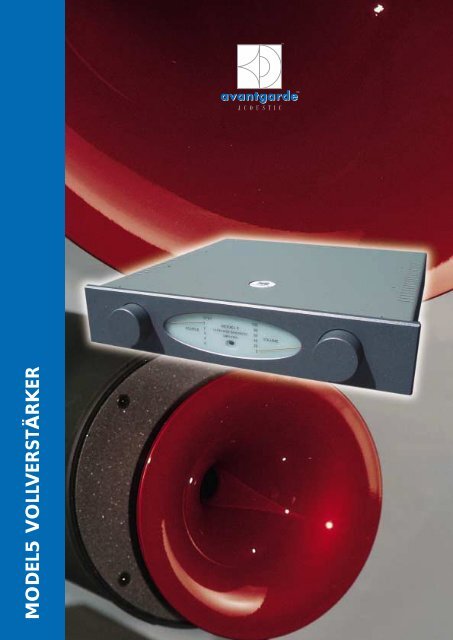
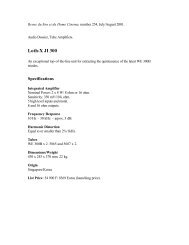
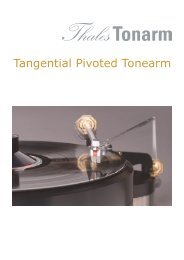
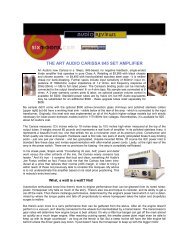
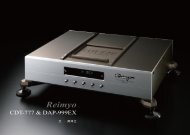

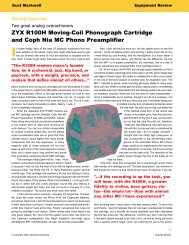
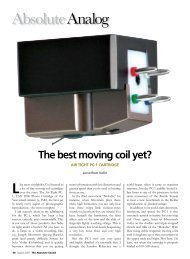
![DAP-999 EX Limited [pdf] - Audio Note Singapore](https://img.yumpu.com/27191044/1/190x253/dap-999-ex-limited-pdf-audio-note-singapore.jpg?quality=85)
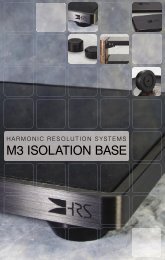
![Harmonix CS-120 Improved-Version [pdf]](https://img.yumpu.com/24411255/1/184x260/harmonix-cs-120-improved-version-pdf.jpg?quality=85)
